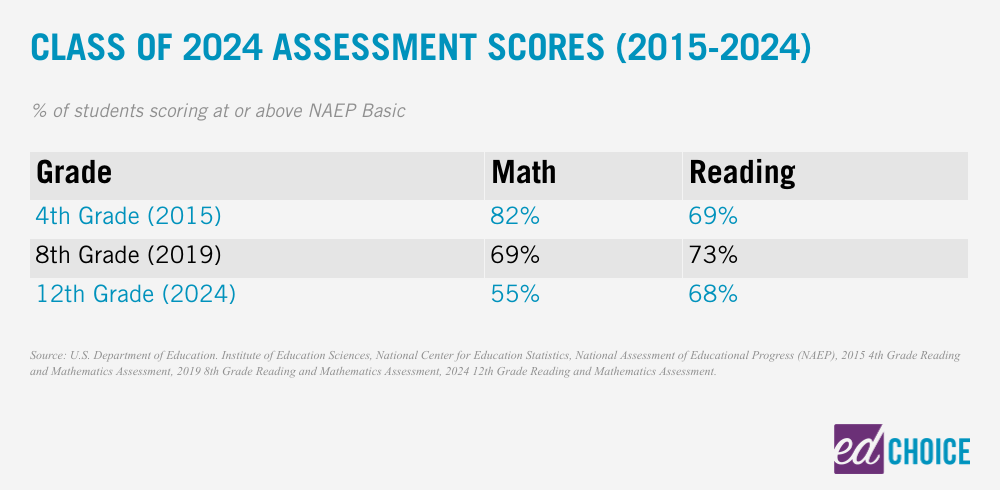Earlier this week, the nation’s report card (NAEP) just released students’ test scores from 2024, giving us the first update on high school seniors’ academic progress since the pre-COVID assessment in 2019. The results are not encouraging.
In 2024, 12th graders’ test scores in math and reading dropped markedly—not just compared to 2019, but to the lowest levels in twenty years. A third of high school seniors (32%) scored below the basic level in reading, and almost half (45%) scored below basic in mathematics. That’s a troubling number of students transitioning into adult life without basic reading and math skills.
Notably, these results are even bleaker if we consider the higher threshold that a student needs to score in order to be considered fully proficient on the NAEP. Only 22% of 12th graders performed at the proficient level or above in math, and only 35% were considered proficient in reading.
The test scores are striking—and perhaps demoralizing—but they also tell the story of a particular high school cohort that faced unique challenges.
The class of 2024 was in eighth grade when the COVID-19 pandemic began. They entered high school in the era of virtual learning and social distancing. Now, they’re graduating into a post-pandemic, AI-shaped workforce that looks very different from the world they grew up in prior to 2020.
To get a picture of what happened, it would be great to see how these students were doing earlier in their life, before the pandemic and all of its related issues. Unfortunately, because NAEP takes a representative sample of students in 4th, 8th, and 12th grades we can’t follow the exact same students over time.
And, also unfortunately, COVID knocked NAEP off of its biennial cadence, so we can’t even track the same cohort through high school. But we can get close. If we look at the NAEP scores for 4th graders in 2015 and 8th graders in 2019 we can get a rough approximation of what students looked like as they progressed through their educational journey on the eve of the coronavirus pandemic.
In 2015, 4th graders showed strong math skills—82% of students performed basic or better in math. They fared somewhat worse in reading, with about two-thirds (69%) of students achieving basic skills. By the time they reached 8th grade in 2019, they’d lost ground in math, with 69% testing at basic or above. On the other hand, their reading skills improved to reach 73%.
Then, the pandemic hit and, five years later, the class of 2024 took the NAEP assessment as high school seniors.[1] Math scores plummeted. Reading scores dropped less dramatically, but all progress made in 2019 was lost.
It doesn’t come as a surprise that the rapid changes to schooling—and life more broadly—during the pandemic have had a significant impact on students. But seeing the results provides further confirmation that we have a lot of work to do.
Following the progress of this cohort over the years makes two takeaways clear: 1. We should not be quick to judge the skills of newly graduated high schoolers, when it would be more apt to apply that scrutiny to how we adapted (or failed to adapt) schooling during the pandemic, and 2. In order to help the class of 2024 successfully transition to college and the workforce, we need to consider that today’s graduates may not be as equipped as prior cohorts and accommodate them accordingly.
[1] Homeschoolers are not included in NAEP assessments and given the substantial growth in homeschooling in the post-pandemic period, there is also a question of missing data for a nontrivial segment of American students.



